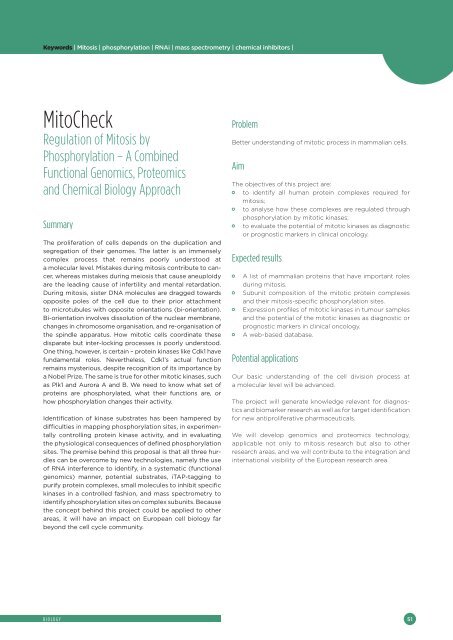You also want an ePaper? Increase the reach of your titles
YUMPU automatically turns print PDFs into web optimized ePapers that Google loves.
Keywords | Mitosis | phosphorylation | RNAi | mass spectrometry | chemical inhibitors |<br />
MitoCheck<br />
Regulation of Mitosis by<br />
Phosphorylation – A Combined<br />
Functional Genomics, Proteomics<br />
and Chemical Biology Approach<br />
Summary<br />
The proliferation of cells depends on the duplication and<br />
segregation of their genomes. The latter is an immensely<br />
complex process that remains poorly understood at<br />
a molecular level. Mistakes during mitosis contribute to cancer,<br />
whereas mistakes during meiosis that cause aneuploidy<br />
are the leading cause of infertility and mental retardation.<br />
During mitosis, sister DNA molecules are dragged towards<br />
opposite poles of the cell due to their prior attachment<br />
to microtubules with opposite orientations (bi-orientation).<br />
Bi-orientation involves dissolution of the nuclear membrane,<br />
changes in chromosome organisation, and re-organisation of<br />
the spindle apparatus. How mitotic cells coordinate these<br />
disparate but inter-locking processes is poorly understood.<br />
One thing, however, is certain – protein kinases like Cdk1 have<br />
fundamental roles. Nevertheless, Cdk1’s actual function<br />
remains mysterious, despite recognition of its importance by<br />
a Nobel Prize. The same is true for other mitotic kinases, such<br />
as Plk1 and Aurora A and B. We need to know what set of<br />
proteins are phosphorylated, what their functions are, or<br />
how phosphorylation changes their activity.<br />
Identifi cation of kinase substrates has been hampered by<br />
diffi culties in mapping phosphorylation sites, in experimentally<br />
controlling protein kinase activity, and in evaluating<br />
the physiological consequences of defi ned phosphorylation<br />
sites. The premise behind this proposal is that all three hurdles<br />
can be overcome by new technologies, namely the use<br />
of RNA interference to identify, in a systematic (functional<br />
genomics) manner, potential substrates, iTAP-tagging to<br />
purify protein complexes, small molecules to inhibit specifi c<br />
kinases in a controlled fashion, and mass spectrometry to<br />
identify phosphorylation sites on complex subunits. Because<br />
the concept behind this project could be applied to other<br />
areas, it will have an impact on European cell biology far<br />
beyond the cell cycle community.<br />
BIOLOGY<br />
Problem<br />
Better understanding of mitotic process in mammalian cells.<br />
Aim<br />
The objectives of this project are:<br />
• to identify all human protein complexes required for<br />
mitosis;<br />
• to analyse how these complexes are regulated through<br />
phosphorylation by mitotic kinases;<br />
• to evaluate the potential of mitotic kinases as diagnostic<br />
or prognostic markers in clinical oncology.<br />
Expected results<br />
• A list of mammalian proteins that have important roles<br />
during mitosis.<br />
• Subunit composition of the mitotic protein complexes<br />
and their mitosis-specifi c phosphorylation sites.<br />
• Expression profi les of mitotic kinases in tumour samples<br />
and the potential of the mitotic kinases as diagnostic or<br />
prognostic markers in clinical oncology.<br />
• A web-based database.<br />
Potential applications<br />
Our basic understanding of the cell division process at<br />
a molecular level will be advanced.<br />
The project will generate knowledge relevant for diagnostics<br />
and biomarker research as well as for target identifi cation<br />
for new antiproliferative pharmaceuticals.<br />
We will develop genomics and proteomics technology,<br />
applicable not only to mitosis research but also to other<br />
research areas, and we will contribute to the integration and<br />
international visibility of the European research area.<br />
51
















